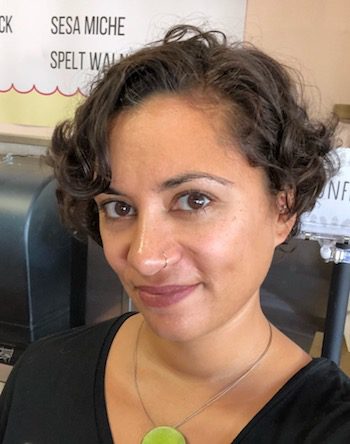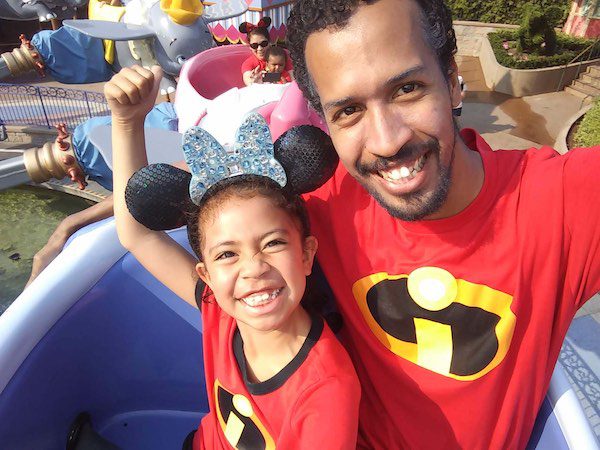Elena Rivera was standing in the frozen food aisle on the phone with her mother when she finally said out loud, “I think I need to go to therapy.”
Rivera had just moved away from her support network for a new job in North Carolina. Her car had broken down, she was really anxious at work, and after months of being stressed and lonely she made up her mind.
Her mother’s response? “Oh, good. I was going to bring that up.”
Find resources and more stories that go #beyondselfcare to start a new conversation about mental health.
It helped that Rivera’s mom was supportive. But finding an excellent and affordable therapist is tough under any circumstance. For people of color like Rivera, there can be an added challenge: identifying someone who isn’t clueless or downright harmful when it comes to race.

Photo: Courtesy of Elena Rivera
Shortage of Options
For those seeking a mental health professional of color, the numbers are daunting. Minorities accounted for only 16 percent of the psychological workforce in 2016 according to the American Psychological Association, which estimates a 24 percent increase in demand for therapists from people of color by 2030. Resources like the Institute for Muslim Mental Health, the Society of Indian (Native American) Psychologists and Therapy for Black Girls can help. But sometimes therapists who show up on lists are just people who clicked a box saying they use “multicultural” approaches, not people of color themselves.
For Rivera, the first therapist she found after talking with her mom was, in her words, “a nice, old, white lady.” Rivera is 28 and Latina. She said the therapist was reasonably helpful on the stress of applying to grad school and being away from friends and family, but the race barrier created moments of miscommunication.
“I was telling a story, but she wasn’t hearing all of it,” Rivera said, remembering a time when she was describing to her therapist how she felt like an impostor sometimes. “I wish she would have somehow been able to tell me: ‘This makes sense because of the different parts of your identity that are intersecting.’”
Not knowing whether your counselor understands the core aspects of your identity can throw off the therapeutic dynamic. All those microaggressions people of color face in day-to-day life can find their way into the therapy office, and pretty soon the client is sitting there helping or educating the therapist when it’s supposed to be the other way around. Subtleties get lost in the cultural divide. Or sometimes the client will avoid the subject of race altogether.

Holding Race Back
Amara Fisher is mixed race, her mom white and her dad black.
But her therapist doesn’t know that.
“We’ve been having these conversations about my mom and my relationship with my dad, but I have never mentioned their ethnicity and she has never asked,” Fisher said. “I feel like I’m lying by omission. I really don’t want to know or see her reaction, and I don’t know if she can be helpful. It has the potential to turn me off from the relationship entirely.”
Originally from New Hampshire, Amara Fisher said her first experience with mental illness occurred in college, and that the race of her therapist wasn’t an issue because her “brain was in chaos.” (Photo: Courtesy of Amara Fisher.)
Filtering what you share with your therapist is not necessarily unusual, said Anisha Mauze, who is Indian American and an associate therapist in private practice in the San Francisco Bay Area, but she cautions against it. If a therapist reacts poorly to the way a client talks about race? “You two are not a good fit anyway,” Mauze said. And having a good connection with your therapist is, in her view, 80 percent of the work. Without that, it could be best to move on.
Switching for a Better Fit
That’s what Lauren Chinn said she did after about six months of seeing her former therapist, and culture had a lot to do with it.
“She tried to make all these assumptions about my Chinese culture,” said Chinn, who lives in San Francisco and is a web developer. “She was trying to be culturally sensitive, but she was making assumptions about me instead of understanding the culture I was in.”
Even if a misunderstanding with her therapist didn’t deal directly with race, it could still feel like it did to Chinn. She recalled when the two of them argued about how long it would take Chinn, 29, to clean her room. The therapist insisted it would take two hours, and Chinn knew it would be closer to 16 (she has ADHD). Chinn was frustrated that her therapist acted as if she knew better.
“I feel like white supremacy teaches white people that they know things,” said Chinn, who tired of the dynamic. So she used a progressive Asian American Christians Facebook group to find a therapist with whom she had a better cultural connection.
“There is already so much background that we share that I don’t have to explain everything,” she said of her current therapist. “When I have a problem that I want to solve in a certain way based on my values, I don’t have to fight against my therapist about what are my values in the first place, before actually working toward it.”
Therapist in Therapy

It’s not just a matter of shared values. Roberto Garcia is an associate therapist himself and practices at a Bay Area high school. In his own therapy as a client, a counselor once encouraged Garcia to give himself permission to get mad. In public.
Garcia is 6’5” and black.
He said he understood that the therapist was trying to address a genuine concern in his life — that he didn’t feel safe expressing frustration. But the racial context was missing. “I know my anger is seen as a threat. Society is not ready to handle my anger,” he said. “And you’re telling me to flaunt it around as if it’s not going to end up causing some kind of massive blowback on me or something?”
As a therapist himself, Garcia takes his own mental health seriously, but given the landscape, he’s kept his expectations low. “I wasn’t likely to find somebody who resonated with me on the same ethnic background.”
For those who can’t get professional help with their mental health, some find healthy ways to deal, like dance, faith or friends. But there’s also a tendency to self-medicate, according to Dr. Annelle Primm from The Steve Fund, an organization dedicated to the mental health of young people of color in honor of Stephen C. Rose, a 29-year-old who died by suicide. Food, drugs, alcohol or sex may bring pleasure initially, but in excess, people are “placing themselves at risk for a host of other mental health, physical health, and social problems,” said Primm.
Before working at Steve Fund, Primm was the director of minority and national affairs for the American Psychiatric Association. While she understands why people of color may feel the need to see a therapist of a similar race, she cautions against holding out for one. The math means it’s often not possible. What’s more important, she said, is that therapists approach differences in race with “cultural humility,” which means learning without the patient teaching and setting aside their own bias or assumptions.
And very good listening.
“The Talk” … With Your Therapist
So what’s the best way forward if you’re, say, black, and you end up with a therapist who seems decent but doesn’t share your race, and you’re just not sure if they get you enough?

Photo: Courtesy of Demetria Gallaread.
“If you’re still concerned after about three sessions, that’s when you say: I really need to take my black identity seriously and I would like to work with you to figure that out, “ advised Demetria Gallaread. “And then that’s when you get to know your therapist’s experience with this. What they do know, what they don’t know. You can work through it together if you need to.”
Gallaread, 28, said she’s been seeing a white therapist in Chicago for four years, who doesn’t always get the race stuff right. It can often feel tertiary to the things they discuss rather than integrated. But Gallaread said it’s working for her so far: “I’m taking what I can get.”
This story was originally published on May 13, 2019.
